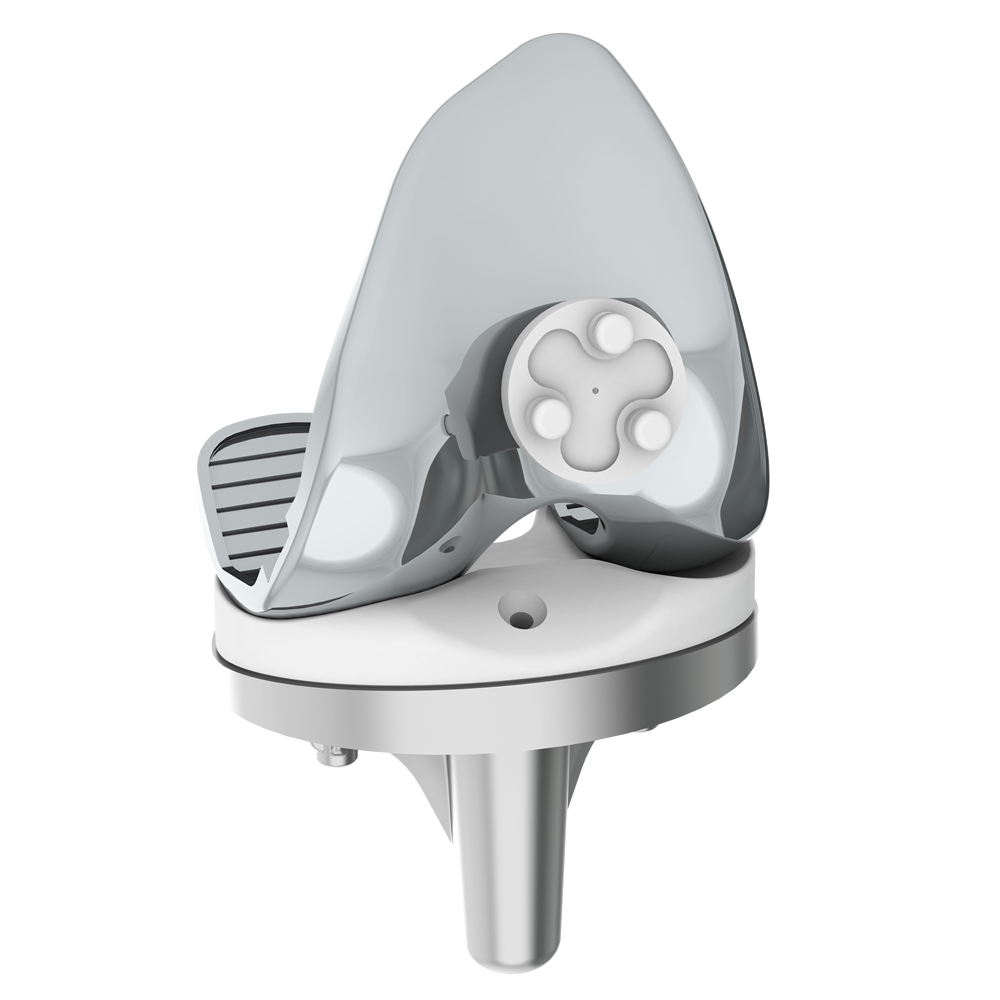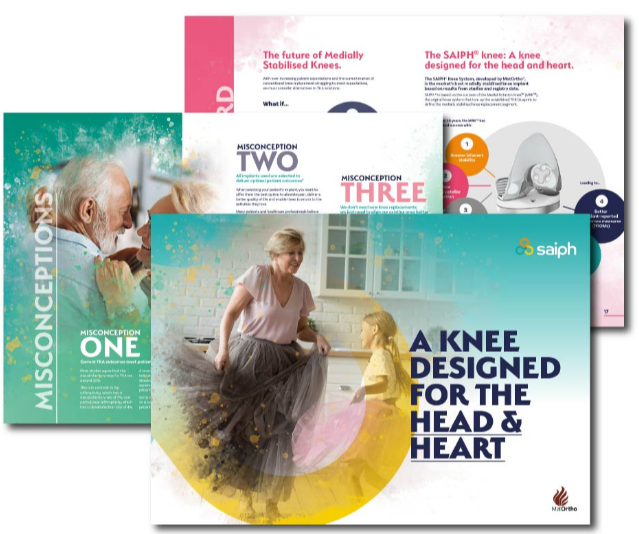SAIPH® Knee System
The 2nd generation medial ball-and-socket knee
- Products
- SAIPH® Knee System
About the SAIPH® Knee
The SAIPH® Knee is a 2nd generation medial ball-and-socket knee. It is an evolved design based on the clinically successful Medial Rotation Knee™ (MRK™) that has been used since 1994. Like the MRK™, the SAIPH® Knee was designed on the principle that by providing natural asymmetry across all three compartments, better function and increased patient satisfaction can be achieved without the compromises of other total knee replacement (TKR) designs. The design principle was proven with the Medial Rotation Knee™ and is now demonstrated with the SAIPH® Knee.
A knee designed for the head and heart
With 95% of patients satisfied with their outcome, the SAIPH® knee can support you to help patients live a life more like the one they want to lead. [1-3]
At MatOrtho®, we support orthopaedic leaders to improve patient satisfaction by offering an alternative to the current TKA procedures.
Learn more about the SAIPH® knee system.
Natural asymmetry, complete stability and full mobilisation
The SAIPH® Knee System is the 2nd generation medial ball-and-socket knee from the originators of the concept. The design is based on the principle that by providing natural functional and anatomical asymmetry in all three knee compartments (medial tibiofemoral, lateral tibiofemoral and patellofemoral articulations), better function and increased patient satisfaction can be achieved without the compromises of traditional total knee replacement designs.
The result is provision of complete inherent stability throughout the range of motion, coupled with allowance for physiological rotation during flexion. The design also features a physiologically asymmetric patellofemoral joint for a more natural feel and ease of flexion.
The SAIPH® has been in clinical use since 2009. Following on from 20 years of clinical success with the Medial Rotation Knee™ (MRK™), the SAIPH® retains all key design features fundamental to the clinical success of the principle.
Clinical data shows that patients can expect:
- Inherent full ROM stability [1], like the normal knee [2];
- An excellent range of motion, with a device that permits over 150° flexion [1,3];
- Significant health gains and improvements in function [3];
- Excellent survivorship [3-5], with a device that has an ODEP 7A rating [6].
Physiological stability and mobility for the active knee without compromise
The SAIPH® Knee has been in clinical use since 2009 with over 10,0001 knees implanted worldwide. It is the only TKR in the world designed wholly for the medially stabilised concept without compromise.

Natural asymmetry
- Physiological medial stability
- Lateral freedom to move AP
- Physiologically lateralised trochlea
- Anatomically designed, CT validated
- Normal feeling of stability and movement
Complete stability
- Substitutes for the ACL, PCL and meniscus
- Inherent full ROM stability
- No mid-flexion instability
- Lateral stability where required
- Patella naturally stabilised throughout ROM
Full mobilisation
- Physiological rotation during flexion
- Exhibits lateral femoral rollback
- Femur maintained posterior for efficient extensor mechanism
- Reduces anterior capsule tension in flexion
- Permits over 150° flexion
Designed without compromise
- Highly conforming, low contact stress for low wear
- No post; no box cut; avoids challenges with PCL retention
- Proportional flexion radii for the patient population
- Tibia locking mechanism eliminates micromotion
- Advanced instrumentation with all surgical options
A pedigree with heritage and clinical data
- Evolution of the original ball-and-socket knee
- In clinical use since 2009 and ODEP 7A rated6
- Low revision rates, better high-end activity
- Greater patient-reported success and satisfaction
- A step further for the ‘forgotten knee’
Expert insights from surgeons
The SAIPH® Knee has a very positive and broad spectrum of data to support surgeon and hospital evidence-based decision-making processes.
Below, are several useful and informative presentations from surgeons who use the SAIPH® Knee System.
Resources
www.njrcentre.org.uk
SAIPH® Flyer
Download Now
Fill in your details below to download the SAIPH® Flyer.
SAIPH® Clinical Rationale
Download Now
Fill in your details below to download the SAIPH® Clinical Rationale
SAIPH® Brochure
Download Now
Fill in your details below to download the SAIPH® Brochure.
SAIPH® Operative Technique
Download Now
Fill in your details below to download the SAIPH® Operative Technique
A Patient Guide To Knee Replacement - The SAIPH® Knee
Download Now
Fill in your details below to download the A Patient Guide To Knee Replacement - The SAIPH® Knee


SAIPH® eBook
Who this eBook is for...
Orthopaedic surgeon leaders
As an orthopaedic leader, you’re driven to provide the best possible care and outcomes for your total knee patients. Throughout this eBook, you’ll read about current misconceptions relating to today’s total knee arthroplasty (TKA) implants.
Registrars
As you enter your final years of training, you’ll seek ways to give your current and future patients the best outcomes. In this eBook, you’ll see how to challenge current thinking with new approaches that could help you to better help your patients.
GPs
As the hub of your local community, you want to understand what’s best for your patients so you can put them on the right path for further medical assistance. Throughout this eBook, you’ll read about the latest thinking in total knee replacement to support you in making the best clinical recommendations for your patients.
Download eBook
Please complete the form below.
References
- Shimmin A, Martinez-Martos S, Owens J, Iorgulescu AD, Banks S. Fluoroscopic motion study confirming the stability of a medial pivot design total knee arthroplasty. The Knee. 2015; 22(6): 522-526.
- Johal P, Williams A, Wragg P, Hunt D, Gedroyc W. Tibio-femoral movement in the living knee. A study of weight bearing and non-weight bearing knee kinematics using ‘interventional’ MRI. J Biomech. 2005; 38(2):269-76.
- Data held on file at MatOrtho Ltd. 2016.
- National Joint Registry. Implant Summary Report, Ref: Summary.Report.KP_Femoral_Saiph.15/08/2016.20:48 (held by MatOrtho Ltd.)
- Australian Orthopaedic Association National Joint Replacement Registry, Hip and Knee Arthroplasty, Annual Report 2015. https://aoanjrr.sahmri.com/annual-reports-2017
- Orthopaedic Data Evaluation Panel (ODEP). Latest ODEP ratings can be found at www.odep.org.uk

.png)



